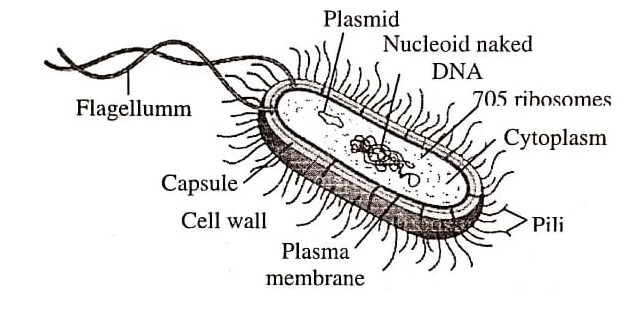Examination of a prokaryotic cell reveals various component structures. Some of the structures are naturally common to almost all prokaryotes, but some structures are present in certain species. Structures found external to the bacterial cell wall aid in protection, attachment, motility, or conjugation. Figure shows a typical prokaryotic cell.

The prime features of a prokaryotic cell are:
- The cell is enclosed within a cell wall, made up of peptidoglycan (a mixture of carbohydrates, and amino acids). The cell wall prevents the cell from bursting.
- Inner to the cell wall, plasma membrane is present which controls the movement of materials in and out of the cell. Some substances are pumped in and out of the cell via active transport.
- The inner area of cell is occupied by cytoplasm, containing enzymes (required for cellular chemical reactions) and the genetic material.
- The region in the cytoplasm having chromosome is known as nucleoid. The DNA is not bound by a nuclear envelope and is naked, i.e., not associated with any protein. Some bacteria contain plasmids (small circular DNA) which replicate independently and passes from one cell to another.
- Ribosomes are the site of protein synthesis and are present in all prokaryotic cells. Cells actively involved in producing protein have large number of ribosomes. In prokaryotic cells 70S ribosomes are present that are smaller than 80S ribosomes found in eukaryotic cells.
- Some prokaryotic cells possess flagellum (singular flagella) projecting out from the cell wall, and enabling cell movement.
- The cell wall of some bacterial cells has pili (singular pilus), through which they can connect with other bacterial cells. This helps in exchange of genetic material.
The volume of prokaryotic cells is less than that of the complex cells, since they lack nucleus.
They undergo division via binary fission. With their growth, the DNA replicates and separates into two different cytoplasmic areas, which further divides into two. This division mechanism is slightly different from mitosis undergone by eukaryotic cells.
| Read More Topics |
| Steps in neurohumoral transmission |
| Drugs Used in Parkinson’s Disease |
| Function of autonomic nervous system |
| Transmembrane enzyme linked receptors |





